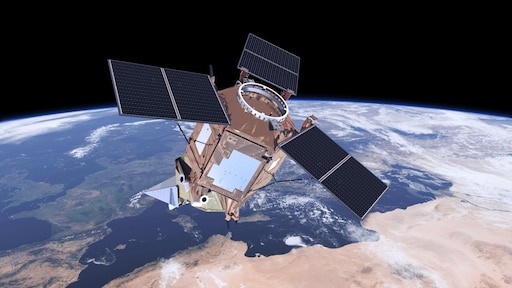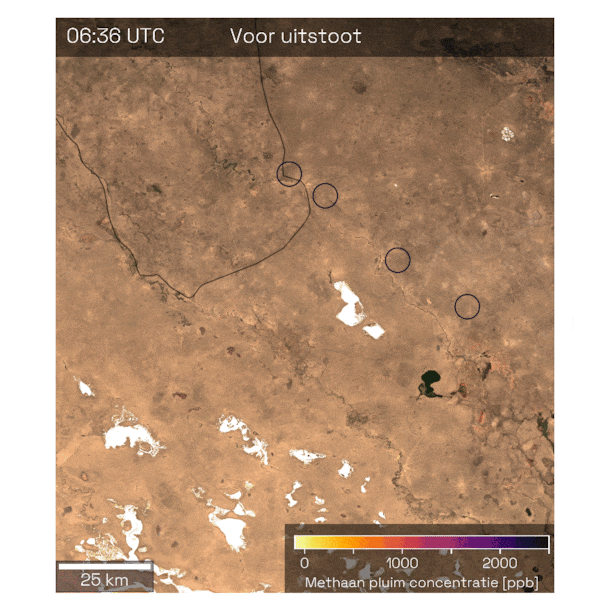Major methane leaks increasingly detected from space


Every week, dozens of large methane leaks are detected from space worldwide, using a Dutch satellite instrument. A new method ensures that the leaks can now be tackled more quickly.
Because before the exact source can be traced and action can be taken through the United Nations against the leaks of the super-potent greenhouse gas, some of them will already have passed.
While some of these methane leaks have a climate impact comparable to what ten thousand cars emit for an entire year, according to the Netherlands Institute for Space Research SRON.
Methane is a much more powerful greenhouse gas than CO2, and therefore a major source of concern. It is mainly released in livestock farming and during oil and gas extraction. Landfills and swamps are also known sources of methane.
Cow Berta emits less methane than her peers and that is good news:
But especially during the extraction of oil and gas, large unintended leaks occur. That is why a worldwide alarm system was set up a year and a half ago, to be able to find these leaks from space. In the meantime, hundreds of methane leaks have been reported.
The system that does this is called MARS, or Methane Alert and Response System. The Netherlands plays a major role in this, because of the Dutch satellite instrument Tropomi. Ever since Tropomi was launched into space more than seven years ago, the global air quality and methane emissions have been mapped daily.
Every week, research institute SRON makes an overview of the largest methane plumes. With smaller satellites, which have a higher resolution, the exact source can then be traced. The UN then informs the responsible companies and governments.
But this procedure is time-consuming. Often the leak is already over before the exact source could be found to be able to address those responsible. By using yet other satellites, mostly weather satellites, action can be taken more quickly.
Here you see a methane release from a gas pipeline in Kazakhstan on September 23, 2024. In less than 4 hours, a total of more than 1.5 kilotons of methane was emitted from 4 locations.

"In some cases, companies or governments don't even know that so much methane is escaping," says researcher Tobias de Jong of SRON. Then it is also in the interest of the companies themselves. Because what does not leak can be sold as natural gas.
Ten thousand carsAccording to De Jong, sometimes much more methane is released in one day than is reported by companies or governments themselves for an entire year.
"For example, in Oklahoma, we saw a plume on two days that released over 400 tons of methane. The previous annual reported emissions from that location were lower than either of these plumes."
In recent years, more and more attention has been paid to methane, because this greenhouse gas breaks down relatively quickly. While CO2 remains in the atmosphere for hundreds of years, methane disappears after about ten years. If we succeed in reducing methane emissions, this will have a much faster cooling effect.
Reducing methane emissions is therefore seen as one of the fastest ways to combat global warming. Almost 160 countries, including the Netherlands, have agreed to reduce methane emissions in the short term.
In the past six months, the new method has already been used to detect some 50 major methane leaks. For example, the researchers saw a large methane plume in Kazakhstan.
It turned out to be a gas discharge from a pipeline, in which more than 1.5 kilotons of methane were blown into the air. The climate impact of this is the same as the annual emissions of ten thousand cars. A large plume was also seen, originating from a gas pipeline in Bulgaria.
Low hanging fruitIt often concerns countries far away. But, says De Jong, it also regularly concerns countries from which we buy natural gas. "That also has an impact on our own footprint." Within the EU, leaks are only sporadically seen from space. Although installations in the North Sea, for example, remain out of sight, because seawater is often too dark to be able to measure properly.
Tackling the leaks is actually low-hanging fruit, which companies themselves also have an interest in, says Bram Maasakkers, also from SRON. "It's really about throwing away your own valuable gas."
Still, there is much to be gained from actually stopping the leaks. "We see these leaks all over the world," says Maasakkers, "and there are already a few success stories in dealing with them in different countries." But actually stopping the leaks is not as easy as detecting them.
RTL Nieuws







